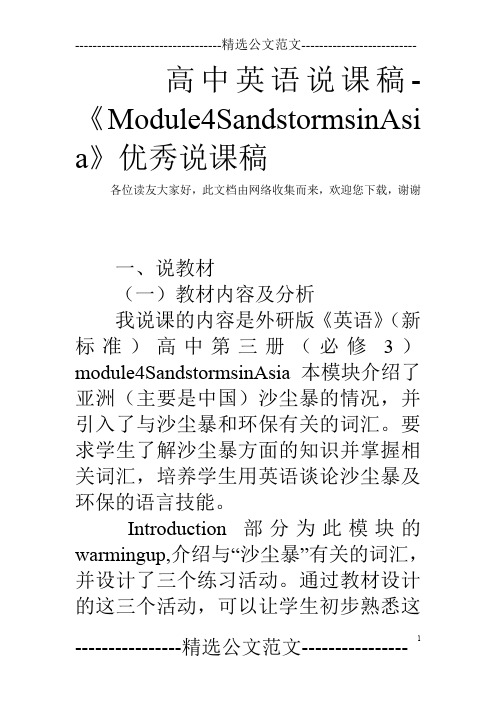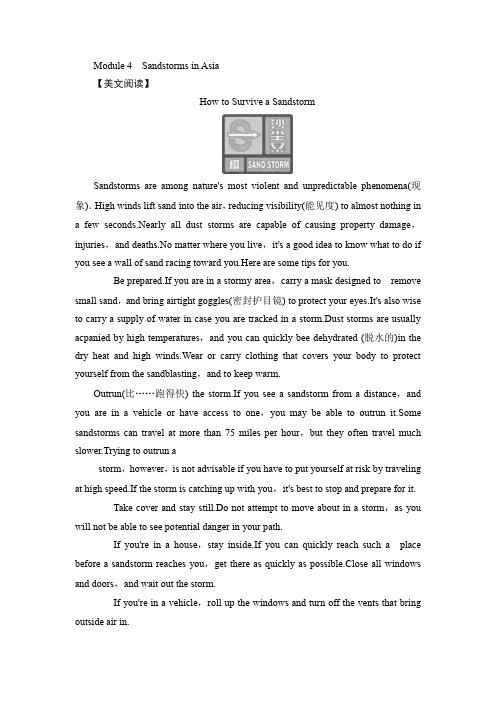2017-2018学年高中英语 Module 4 Sandstorms in Asia Sectio
- 格式:doc
- 大小:3.57 MB
- 文档页数:13


高中英语说课稿-《Module4SandstormsinAsi a》优秀说课稿各位读友大家好,此文档由网络收集而来,欢迎您下载,谢谢一、说教材(一)教材内容及分析我说课的内容是外研版《英语》(新标准)高中第三册(必修3)module4SandstormsinAsia本模块介绍了亚洲(主要是中国)沙尘暴的情况,并引入了与沙尘暴和环保有关的词汇。
要求学生了解沙尘暴方面的知识并掌握相关词汇,培养学生用英语谈论沙尘暴及环保的语言技能。
Introduction部分为此模块的warmingup,介绍与“沙尘暴”有关的词汇,并设计了三个练习活动。
通过教材设计的这三个活动,可以让学生初步熟悉这些词的意义,为以后的各项学习活动做好准备。
ReadingandV ocabulary该部分介绍了“亚洲的沙尘暴”。
围绕着课文,编者设计了五个与课文内容和词汇有关的练习。
通过这些练习,学生可以增进对沙尘暴危害性的了解,熟悉有关沙尘暴的词汇。
(二)教学目标根据《新课标》总目标的描述,结合本课的内容,我把本节课的教学目标系统化,分别是:语言知识,能力目标,情感目标,文化意识,和学习策略。
.语言知识目标掌握并能运用下列词汇:与沙尘暴有关:disaster,dune,citizen,dust,desertification,fo recast,strength,cycle,mask与环保有关:process,mass,campaign句子: Tohavebeencaughtinasandstormwasaterribl eexperience.Therewasnothingtobedone. Tobecyclinginasandstormisfrightening.2.语言技能目标:理论依据:高中英语课程标准强调用英语获取和处理信息的能力).能从中获取主要信息并摘录要点2).能理解主旨、作者意图3).能提取、筛选和重组中的信息4).能利用上下文猜测新词汇3.学习策略目标词汇归类在阅读、英语互动、完成任务过程中进行有效自我调控通过各种途径获取相关信息,辨别并运用有效资源3.文化意识和情感态度目标了解亚洲沙尘暴的状况增强环保意识4.重点与难点重点:了解沙尘暴;阅读微技能训练难点:运用所学词汇和短评,围绕主题进行讨论及写作二、说学情在教学过程中,对学情的了解是教师因材施教的关键。

Module 4 Sandstorms in Asia Section Ⅴ Writing-环保类作文环境污染已成为愈来愈受关注的社会问题,这方面的短文不仅是对现实的展现,也是呼吁人们对环境问题的关注;同时,也要求人们增强环境爱惜意识。
一、大体结构第一部份:提出问题(现状)并分析问题(造成的缘故)。
第二部份:提出建议或分析计谋,展望以后或发出号召。
二、增分句式①One of the major environmental problems is ...②There is a serious problem with ...③The pollution is caused by ... and it is becoming more and more severe.④Many ... are damaged/harmed/destroyed by ...⑤In order to ... the government should ... and we citizens must ...⑥In my opinion, we can ...⑦In a nutshel l ...[题目要求]请依照下表提示,写一篇关于环境问题和如何注意爱惜环境的作文。
词数100左右。
环境问题大气污染、水污染、沙尘暴等原因现代社会的迅速发展,人们对大自然的破坏结果有害人类的健康,使动植物灭绝我的建议……一、审题1.确信文体:本文是关于环保话题的夹叙夹议类的、提示性的作文;2.确信人称:本文的要紧人称为第三人称;3.肯按时态:要紧以一样此刻时为主,提出建议时,能够用一样以后时。
二、构思第一段:描述存在的环境问题,并分析缘故和危害。
第二段:提出建议。
第二步:核心辞汇想全面1.environment 环境2.pollution 污染3.polluted 被污染的4.do_harm_to 对……有害5.disease 疾病6.die_out 灭绝7.be_responsible_for 对……负责8.As_far_as_I’m_concerned 在我眼里9.measure 方法10.punish 处惩第三步:由词扩句雏形现1.此刻,显现了很多环境问题,如大气污染、水污染、沙尘暴等。

Module 4 Sandstorms in Asia Section Ⅳ Other Parts of the Module[原文呈现]The Green Movement①Some countries are better than others at②looking after③the environment. In Europe, Germany and the northern European countries work very hard to improve the environment. People in countries such as Germany put their garbage into④different bags — paper in one bag, plastic in another bag, etc. The garbage is then taken away⑤and, if possible⑥,recycled⑦. CFCs (chloroflurocarbons), chemicals which are found in refrigerators and aerosol cans⑧,are not allowed⑨. There are laws that do not allow people to burn too much coal⑩.In the 1970s⑪,as people learnt more about environmental problems⑫,the “Green” movement began and soon spread⑬all over⑭Europe. The “Green” movement tries to get governments to think⑮seriously about the environment and how to look after it. It collects information about how industry is damaging the environment and gives this information to newspapers.[读文清障]①the Green Movement绿色运动②at在此处表示“在……方面”。

Module 4 Sandstorms in Asia Section Ⅲ Grammar 动词不定式和but+不定式语法图解探讨发觉①Experts hope to learn more about the movement of thunderstorms.②There was nothing to be done.③The storms sometimes continue all day and traffic moves very slowly because the thick dust makes it difficult to see.④When a sandstorm arrives in the city, weather experts advise people not to go out.⑤It is difficult to breathe and the dust makes me ill.⑥To prevent it coming nearer, the government is planting trees.⑦My job is to teach.⑧I can do nothing but wait at home.⑨She has no choice but to give in.[我的发觉](1)①~⑦句中,不定式在句中别离充当宾语、定语、宾语、宾语补足语、主语、状语和表语。
③句中,it 为形式宾语;⑤句中,it为形式主语。
(2)由④句可知,不定式的否定式为not_to_do。
由②句可知,不定式的被动式为to_be_done。
(3)由⑧⑨句可知,不定式在介词but后面时,若是but之前有行为动词do的各类形式,那么介词后的不定式不带to,不然带to。
一、动词不定式(一)动词不定式的时态和语态语态主动被动时态一般式to do to be done进行式to be doing /完成式to have done to have been done1I hope to see you next week.我希望下周能见到你。

Module 4Sandstorms in Asia【美文阅读】How to Survive a SandstormSandstorms are among nature's most violent and unpredictable phenomena(现象).High winds lift sand into the air,reducing visibility(能见度) to almost nothing in a few seconds.Nearly all dust storms are capable of causing property damage,injuries,and deaths.No matter where you live,it's a good idea to know what to do if you see a wall of sand racing toward you.Here are some tips for you.Be prepared.If you are in a stormy area,carry a mask designed to remove small sand,and bring airtight goggles(密封护目镜) to protect your eyes.It's also wise to carry a supply of water in case you are tracked in a storm.Dust storms are usually acpanied by high temperatures,and you can quickly bee dehydrated (脱水的)in the dry heat and high winds.Wear or carry clothing that covers your body to protect yourself from the sandblasting,and to keep warm.Outrun(比……跑得快) the storm.If you see a sandstorm from a distance,and you are in a vehicle or have access to one,you may be able to outrun it.Some sandstorms can travel at more than 75 miles per hour,but they often travel much slower.Trying to outrun astorm,however,is not advisable if you have to put yourself at risk by traveling at high speed.If the storm is catching up with you,it's best to stop and prepare for it.Take cover and stay still.Do not attempt to move about in a storm,as you will not be able to see potential danger in your path.If you're in a house,stay inside.If you can quickly reach such a place before a sandstorm reaches you,get there as quickly as possible.Close all windows and doors,and wait out the storm.If you're in a vehicle,roll up the windows and turn off the vents that bring outside air in.If you are outside,seek out a large rock to protect yourself at least partially.Protect yourself from flying objects.Cover as much of your body as possible to protect yourself from flying sand.In addition,while the sand can hurt,a sandstorm's high winds can also carry heavier(and hence more dangerous) objects.If you find yourself no place to stay,try to stay low to the ground and protect your head with your arms, or a backpack.【诱思导学】Sandstorms have been a major disaster for many Asian countries for centuries.What should we do to reduce or stop sandstorms?【答案】Students' own answer.Period ⅠPreviewing●教学目标本课时主要是通过学生对学案所给出的内容的学习,了解本课文中所出现的词汇,初步了解课文以及相关的背景知识,对下一堂课对课文的全面理解起到一个铺垫作用。
Module 4 Sandstorms in Asia Period 4 Integrating Skills Ⅰ. 完形填空A thousand years ago Hong Kong was covered by a thick forest like the forests we now find in Malaysia and Thailand. As more and more 1 came to live in Hong Kong, these trees were cut down and burnt. Now there is no forest left, 2 there are still some areas covered in trees. We call these 3 .Elephants, tigers, monkeys and many other animals used to live in the 4 forests of Hong Kong, and there were even crocodiles in the 5 and along the coast. When people came to live 6 Hong Kong, the animals began to die out. Early farmers drained(排干)the valleys to 7 rice and to keep pigs and chickens. They 8 the trees and burnt them. They needed fires to keep themselves 9 in winter, to cook their food, and to keep away from 10 animals. Elephants quickly disappeared because there was not enough 11 for them. So did most of the wolves, leopards and tigers. Monkeys, squirrels and many other animals soon died out in the same way.You might think that there are 12 any animals in Hong Kong, except in the zoos. You might think that there cannot be any wild animals in such a 13 place, with so many cars and buildings. But there is 14 a good deal of countryside in Hong Kong and the New Territories(新界), and there are still about thirty-six different kinds of animals living there.One of the most interesting of Hong Kong’s15 is the barking(吠叫)deer. These are beautiful little creatures(生物)with a rich, brown coat and a white patch(斑)under the tail. They look like deer but they are much 16 . They are less than two feet high. The male barking deer has two small horns(角)but the female has none. They make a 17 rather like a dog barking.Barking deer live in thick shrub(灌木)country and are very good at 18 . They eat grass and shrubs, and go outside mainly in the very early morning and late afternoon and evening. This is when you are most likely to see one but you will need to be very quiet and to have very sharp 19 .In Hong Kong the barking deer has only one 20 —man. Although it is illegal(非法的), people hunt and trap(诱捕)these harmless little animals. As a result, there are now not many left. There are a few on Hong Kong Island but hardly any in the New Territories.【语篇概述】一千年前, 香港也像马来西亚和泰国一样, 被茂密的森林覆盖。
外研版必修三Module 4 Sandstorms in AsiaNew words1.cut down 砍倒,减少2.major adj.主要的,多数的,主修的,较重要的n.主修课程,主修学生vi.主修+in,专攻3.mass adj.大量的,大规模的,广泛的n.团,块,堆,大量,许多vi&vt.集结,聚集the masses 群众masses of =a mass of 许多,大量(即可修饰可数名词也可修饰不可数名词)plenty of, a quantity of, a mass of, a lot of 修饰可数名词和不可数名词a number of ,a good many, quite a few 修饰可数名词a great deal of, an amount of, quite a little 修饰不可数名词4.be caught in 突然遭遇be trapped in ,be stuck in 被困住5.strength (U)n. 力量,力气,意志力,坚强(C)n. 强项,优势,长处strong adj. strengthen v.加强6.wake up to 醒来时,认识到He was too slow to wakw up to the cold truth.7.have a bad effect 对….有坏的影响8.take in 吸收,欺骗,理解,领会,收留The salesmam has took in the old people to buy their poor goods.9.give out放出,发出(光,热,味),分发,用尽,发表,公布10.nothing but 只有,仅仅He did nothing but sleep at home yesterday. There is nothing left for him but to fight.11.concerned adj.关心的,担心的be concerned about/over/for 关心,挂念Be concerned in/with 牵涉到,与….有关as far as ….be concerned 就…而然/来说concerning 介词“关于”Sentences1.I can’t help but hope that they will succeed. Can’t help/choose but+v. 不得不做……, 只能做They can’t help but to call in the police.2.I couldn’t agree with you more. 我非常同意你的观点。
教学反思本节课设计的是外研社必修三第四模块Sandstorms in Asia,题型为Reading and Vocabulary.本模块主要介绍了亚洲(主要是中国)沙尘暴的情况,并引入了与沙尘暴和环保有关的词汇。
要求学生了解沙尘暴方面的知识并掌握相关词汇,培养学生用英语谈论沙尘暴及环保的语言能力。
一.准确定位教学目标,凸显阅读综合视野一堂课不可能面面俱到,也不能面面俱到。
对于英语阅读课,不同的解读视角,不同的设计目的,会产生不同侧重的阅读课堂。
但是,内容、语言和思维是不可分割的三位一体,三者不能分开独立处理,而是应该综合设计,并有所侧重。
基于本语篇的行文脉络和主要内容,制定了侧重内容层面的教学目标。
经过多次改版,对文本有了更进一步的了解,最终决定以disaster为主线,通过对文本的学习,运用思维导图,帮助学生归纳总结并描述沙尘暴的定义、地点、起因、影响、建议、措施。
同时,经过种种的尝试与思考,深刻地体会到是否能从学生出发,明确教学目标,仔细研究教学内容,准确定位语言输出点决定着一节课的成功与否。
因而,在处理一篇阅读文章的时候,不能单纯地以教师自己对文章的认知来设计教学步骤,不能以教学步骤来解析文本,而是应该站在学生的角度,根据学习目标,合理解析文本进而确立教学环节。
二.熟悉教学步骤,关注学生表现英语学科核心素养中的思维品质的培养,指的是思考辨析能力的培养,包括分析、推断、判断、理性表达、用英语进行多元思维等活动。
想要达到这一培养目标,我们就必须坚持引导学生学会思考,不断地给他们提供思考的机会,如果教师对教学目标,教学步骤不够熟悉,在课堂教学过程中会更加关注自己教学步骤,而忽略了学习的主体--学生。
文本的有些意义隐藏在字里行间,需要教师设计铺垫性任务,使学生通过比较、提炼、概括等活动,逐步体验并推断文本的隐含意义,从而使学生加深课文理解,积累阅读体验,使阅读成为主动的、语言与思维相互作用的、创造性的学习和运用语言的过程。
Module 4 Sandstorms in Asia Section Ⅰ Introduction &Reading Pre-readingIn April 2012, a dust storm that originated in China and Mongolia took a sixday journey across more than ten thousand kilometers of sea and open land to Arizona in the United States. The cloud was so dense that it seemed as if the sun were setting early. At least one person thought a volcano had erupted.Although traveling dust storms are nothing new, the dust now often contains chemical or metallic substances that contribute to respiratory illnesses (呼吸道疾病) and damage the environment. At present, a group of researchers in Asia is studying aerosol particles and their effects on the environment — and they have plenty of dust to work with.Dust storms are one of the repercussions (后果) of humans messing around with Mother Nature. Although they are a natural phenomenon, dust storms have been occurring more often, at shorter intervals, and with greater force in recent years, and human activity is the cause.It is a fact that excessive herding of animals and exploitation of grasslands are responsible for the majority of dust storms. This means that dust storms are largely a result of human actions; in other words, they are controllable.Section_ⅠIntroduction & Reading —Prereading[原文呈现]Sandstorms① in AsiaSandstorms have been a major②disaster for many Asian countries for centuries. Scientists have tried many ways to solve this problem and in China, a mass③campaign④has been started to help solve it.Sandstorms are strong, dry winds that carry sand⑤.They are often so thick that you cannot see the sun⑥, and the wind is sometimes strong enough to move sand dunes⑦. The four main places in the world where there are sandstorms⑧are Central Asia, North America, Central Africa and Australia. Ren Jianbo, from Inner Mongolia described a terrible sandstorm he experienced⑨as a child in the desert. “To have been caught in a sandstorm⑩was a terrible experience,” he said.“There was nothing to be done ⑪. It was the most frightening and the most dangerous situation I’ve ever been in ⑫. You just had to hope you’d survive. I thought I was going to disappear under the sand.”[读文清障]①sandstorm/'sændˌstɔːm/n.沙尘暴②major/'meIdʒə/adj.主要的;多数的③mass/mæs/adj.大量的;大规模的④campaign/kæm'peIn/n.战役;活动⑤that carry sand是定语从句,修饰winds, that在从句中作主语。
⑥so ...that ...“如此……以至于……”,引导结果状语从句。
⑦dune/djuːn/n.沙丘⑧where there are sandstorms是定语从句,修饰the four main places, where在从句中作地点状语。
⑨he experienced是定语从句,修饰sandstorm,从句中省略了作宾语的关系代词which 或that。
⑩动词不定式的完成式to have been caught in a sandstorm作主语。
⑪There was nothing to be done.“一点儿办法也没有/什么也干不了”。
⑫I've ever been in是定语从句,修饰situation。
引导词that或which作介词in 的宾语,所以省略了。
亚洲的沙尘暴[第1~2段译文]几百年以来,沙尘暴一直是许多亚洲国家面临的一个主要灾难。
科学家们已尝试过许多方法解决这个问题,在中国,一场大规模的帮助解决沙尘暴问题的运动已经开始了。
沙尘暴是夹带沙尘的强烈而干燥的风。
沙尘暴常常很浓密,以至于遮住了太阳,有时风力大的足以移动沙丘。
世界上沙尘暴发生的四个主要地区是中亚、北美、中非和澳大利亚。
来自内蒙古的任建波是这样来描述他小时候在沙漠中遭遇的一次可怕的沙尘暴的:“遭遇沙尘暴是一种可怕的经历。
”他说:“你一点儿办法也没有。
那是我遭遇过的最可怕、最危险的境况。
你只能希望自己会活下来。
那时候我以为我要被沙子淹没了。
”Northwest China is part of the sandstorm centre in Central Asia. Sandstorms begin in desert areas. Sandstorms in China appear⑬ to have increased in recent years as a result of “desertification⑭”. This is a process⑮ that happens when land becomes desert because of climate changes and because people cut down⑯ trees and dig up ⑰ grass.Sandstorms sometimes affect Beijing. Citizens⑱ wake up to⑲ an orange sky and21. The storms strong winds ⑳that cover the city in a thick, brownyellow dust○sometimes continue all day and traffic moves very slowly because the thick dust makes22.,⑬appear linkv.看上去;似乎,此处运用了appear to do的完it difficult to see○成式,表动作的完成。
⑭desertification/deˌzɜːtifi’keIʃn/n.(土地的)沙漠化⑮process/’prəʊses/n.进程;过程in the process of (doing) sth.在(做)某事过程中⑯cut down砍倒⑰dig up 掘出,挖到⑱citizen/’sItIzn/n.公民;市民⑲wake up to意识到;认识到⑳定语从句that cover the city ...修饰winds, that在从句中作主语。
21dust/dʌst/n.沙尘;灰尘○22makes it difficult to see中,it是形式宾语。
此处是“make+形式宾语+宾补+○真正的宾语”句式。
[第3~4段译文]中国的西北地区是中亚沙尘暴中心的一部分。
沙尘暴发源于沙漠地区。
“沙漠化”导致的沙尘暴近几年在中国似乎有所增加。
这是一个由于气候变化和人类砍伐树木、铲除草皮而使陆地变成沙漠的过程。
沙尘暴有时候会影响北京。
居民醒来时,看到昏黄的天空,狂风夹着厚厚的黄褐色灰尘在城里肆虐。
沙尘暴有时持续一整天,车辆开得很慢,因为浓浓的尘埃降低了能见度。
23 a sandstorm some weeks beforeThe Chinese Central Weather Station can forecast○24 of the storm sometimes surprises people. it arrives in Beijing, but the strength○When a sandstorm arrives in the city, weather experts advise people not to go out○25. Huang Xiaomei, who lives in Beijing says, “To be cycling○26 in a sandstorm○27 is frightening. The winds are very strong. It’s difficult to breathe○28 and the dust makes me ill. So if you want to go out, you’d better wear a mask○29.”The desert is only 250 kilometres away to the west of Beijing. To prevent it coming nearer○30, the government is planting trees. Already the government has planted more than 30 billion trees and plans to continue planting○31 for the next five years.23forecast/'fɔːkɑːst/vt.预报;预告○其过去式、过去分词为forecast, forecast或forecasted, forecasted。